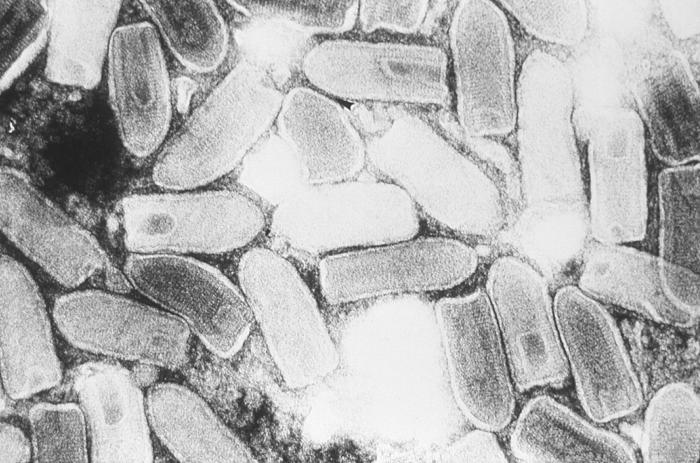Vesicular stomatitis virus
Template:Taxobox begin |- |align=center|File:Vesicular stomatitis virus (VSV) EM 18 lores.jpg |- |colspan=2 align=center|Vesicular stomatitis virus |- Template:Taxobox begin placement virus Template:Taxobox group v entry Template:Taxobox ordo entry Template:Taxobox familia entry Template:Taxobox genus entry Template:Taxobox species entry Template:Taxobox species entry Template:Taxobox species entry Template:Taxobox end placement Template:Taxobox end
Vesicular stomatitis virus (VSV) is a virus in the family Rhabdoviridae, order Mononegavirales. The well-known Rabies virus belongs to the same family. VSV can infect insects and mammals. It has particular importance to farmers in certain regions of the world where it can infect cattle. It is also a common laboratory virus used to study the properties of viruses in the Rhabdoviridae family, as well as to study viral evolution.
VSV is an arbovirus: Natural VSV infections encompass two steps, cytolytic infections of mammalian hosts and transmission by insects. In insects, infections are non-cytolytic persistent.
Vesicular stomatitis virus (VSV) is the prototypic member of the Vesiculovirus genera of the Rhabdovirus family. The genome of the virus is a single molecule of negative-sense RNA that encodes five major proteins: glycoprotein (G), matrix protein (M), nucleoprotein, large protein (L) and phosphoprotein.
Half the genome encodes the L protein, which combines with the phosphoprotein to catalyze replication of the mRNA.
The G protein enables viral entry to the cell by mediating both virus attachment to the host cell and fusion of the viral envelope with the endosomal membrane following endocytosis.
The mRNA encoding the vesicular stomatitis virus M protein is 831 nucleotides long, and encodes a protein of 229 amino acids. The predicted M protein sequence does not contain any long hydrophobic or nonpolar domains that might promote membrane association. The protein is rich in basic amino acids and contains a highly basic amino terminal domain.
The VSVG does not follow the same path as most vesicles because transport of the G protein from the endoplasmic reticulum to the plasma membrane is interrupted by incubation at 15°C. Under this condition, the molecules accumulate in both the endoplasmic reticulum (ER) and a subcellular vesicle fraction of low density called the lipid-rich vesicle fraction. The material in the lipid-rich vesicle fraction appears to be a post-ER intermediate in the transport process to the plasma membrane (PM). When synthesized in polarized epithelial cells, the envelope glycoproteins hemagglutinin of VSVG are targeted to the apical and basolateral plasma membranes. VSVG is also a common coat protein for lentiviral vector expression systems used to introduce genetic material into in vitro systems or animal models. It has the advantage or allowing the virus to infect non-dividing cells like B cells in vitro.

External links
The Lab-On-Site Project has more information about Vesicular Stomatitis Virus.
de:Stomatitis vesicularis nl:Vesiculaire stomatitus Template:WikiDoc Sources